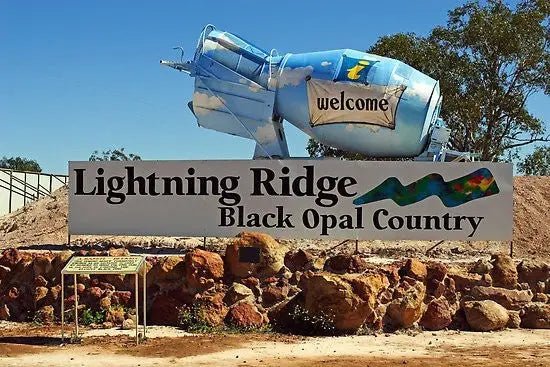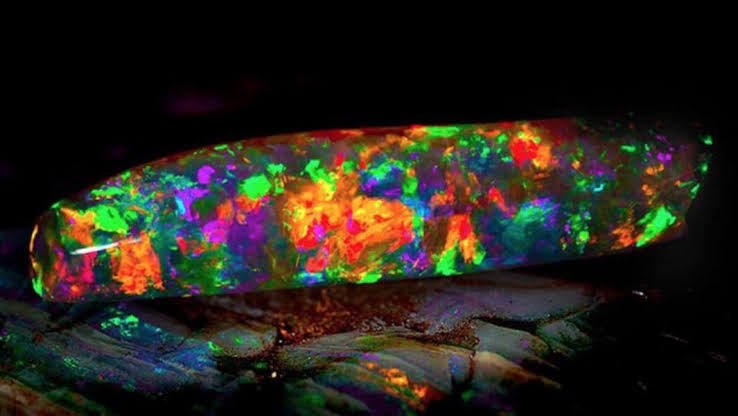
Famous Australian Lightning Ridge Opals: Gems of Remarkable Radiance
When it comes to precious gemstones, opals hold a special place in the world of jewellery and collectibles. Among the various types of opals, those from Lightning Ridge in Australia stand out for their exceptional beauty and quality.
Let's delve into the world of famous Lightning Ridge opals and discover what makes them so special.
The Cutting Quality of Lightning Ridge Opals
Lightning Ridge opals are renowned for their superior cutting quality compared to opals from other parts of Australia. This material is highly predictable, making it an opal cutter’s dream, and it’s also incredibly beautiful. The sandstone host rock is much easier and quicker to work with compared to ironstone (boulder opal) or limestone (Andamooka opal). This ease of working translates to more efficient cutting and shaping processes, resulting in stunning gemstones.
Fascinating Facts About Lightning Ridge Opals
Lightning Ridge produces various types of opals, each with unique characteristics. Here are some fascinating details about the different opal types found in this region:
-
Crystal Opal: Crystal opals from Lightning Ridge are unique because the colour can run through the entire stone, including the base, depending on its clarity. These opals exhibit incredibly vibrant and bright flashes of colour, sometimes even more so than black opals. They are highly pure and, when opaque, can also be referred to as white or milk opals. Composed of hydrated silica, crystal opals are valued for their rarity and unique colour patterns. The most prized variation is the black crystal opal from Lightning Ridge.
-
Black Opal: Black opal is the rarest and most valuable opal type, with top-quality gems fetching up to AUD $6,000 per carat. The dark body tone of black opal enhances the brightness of its colours. While dark opal is found in other areas, true black opal can now only be found in Lightning Ridge, which produces 95% of the world’s supply. The value of black opal depends on factors such as brightness, colour presence, and pattern.
-
White Opal: White opals are the most common form of opal, often featuring a pale body tone with white potch left on the back. Sometimes, the entire stone is colourful, resembling crystal opal. When white opal is partially translucent, it enhances the clarity and vibrancy of the colour, increasing its value. Red, the rarest colour in black opal, occurs more frequently and vividly in white opal.
-
Fossil Opal: Opal can form fossil replicas of objects once buried in sand or clay. While Coober Pedy produces marine fossil opals, Lightning Ridge is known for land animal fossils, including dinosaur opal fossils of previously undiscovered species.
Notable Opal Fields in Lightning Ridge
The Lightning Ridge area has several notable opal fields, each contributing to the region’s reputation as a premier source of high-quality opals:
- The Three Mile: The most productive and extensively worked area.
- Thorleys Six Mile: Known for the first shaft sunk in February 1902, with a resurgence in 1970 yielding high-quality black opals.
- Nobbys: One of the first areas mined, with initial discoveries in gravel at the ridge's base.
- New Nobby: Saw intensive mining starting in 1960 after a prospecting shaft revealed precious opal.
- Deep Four Mile: Produced good quality opal from five claims in the 1930s.
- McDonalds Six Mile: Another productive area close to Rouses Six Mile.
- Nine Mile: Another significant field.
- Nebea Hill: Discovered in 1973, produced over $3 million worth of opal in two years.
- Shallow Belars, Hawks Nest, Bald Hill, New Chum, and Old Chum: Additional fields with varying success.
- Coocoran: Approximately 20 km west of Lightning Ridge, produced 80% of the black opal output in the early 1990s.
- Sheepyard, Grawin, and Glengarry: Notable for extensive opal deposits and significant finds.
- Mulga Rush, Wee Warra North, and Carters Rush: Areas that saw major rushes and significant discoveries.
- New Angledool (Mehi): Discovered in 1924.
Fossicking for Lightning Ridge Opal
Fossicking in Lightning Ridge is permissible in areas not designated as private property or active mines. Mullock heaps (discarded rock and soil) are often found along roadsides and at places like the Lightning Ridge Visitor’s Centre. Recent years have seen more success fossicking on roadsides rather than in heaps, with potential finds everywhere yet nowhere specific.
The Unique Formation of Lightning Ridge Opals
Lightning Ridge opals are formed through a complex geological process. Millions of years ago, the area was covered by a vast inland sea, which left behind silica-rich sediments as it evaporated. Rainwater then percolated through these sediments, dissolving the silica and forming a gel-like substance. This silica gel seeped into cracks and cavities in the surrounding rock, often created by decomposed fossils or plant material. Over millions of years, the water gradually evaporated, causing the silica gel to harden and solidify into opal. The vibrant colours of Lightning Ridge opals result from the diffraction of light through the tiny silica spheres within the opal structure, with the size and arrangement of these spheres determining the displayed colours.
The dark body tone of black opals, which enhances the play-of-colour, makes them particularly striking and sought-after. Geological movements over time brought these opal-rich layers closer to the surface, making them accessible for mining. Lightning Ridge's unique geological history and the specific conditions required for opal formation contribute to the rarity and beauty of its opals. These conditions, combined with the area's distinctive dark opals, make Lightning Ridge one of the most renowned opal mining regions in the world.
Famous Lightning Ridge Opals
One of the most famous Lightning Ridge opals is the "Aurora Australis," a large and exceptionally colourful gemstone that is considered one of the most valuable opals in the world. Another notable Lightning Ridge opal is the "Royal One," known for its rare black opal body tone and intense play-of-colour.
The Allure of Lightning Ridge Opals
Due to their unique colour patterns and exceptional quality, Lightning Ridge opals are highly sought after by collectors and jewellery enthusiasts. The rarity and beauty of these opals make them a prized possession for those who appreciate the natural beauty of gemstones.
Exploring the world of famous Lightning Ridge opals is a fascinating journey into the beauty and wonder of nature's creations. Whether you are a gemstone enthusiast or simply appreciate the artistry of Mother Nature, Lightning Ridge opals are sure to captivate you with their mesmerising play-of-colour and unique charm.




Leave a comment
This site is protected by hCaptcha and the hCaptcha Privacy Policy and Terms of Service apply.